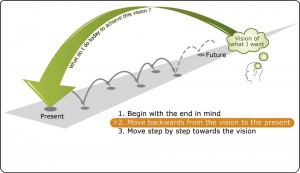Published on
Give Me The Tools For Change: Creating The Future

In my last article (Give Me The Tools For Change Part 1) I talked about the tools for change and advocated the use of the change kaleidoscope as a tool that could be used as part of a change management program in Further and Higher Education.
However, before you can embark on your change journey you need to know where it is you are going, and what it looks like when you get there, that’s assuming you can get there, otherwise how will you know that you have arrived?
This article is the second of the three-part series.
Creating the (or a) future may sound a bit preposterous, especially in today’s unstable economic environment. Notwithstanding the political influences educations systems are subject to around the world.
Creating a future either on a personal or business level is necessary if you want a clear sense of direction, something to aim for. I don’t mean an aspirational future, I mean a future that is within your grasp—one that is possible to achieve.
When athletes are training for events they want to win, they are often told to imagine what it would be like as they cross the winning line, this provides them with some of the motivation to win. Whilst they still need the courage to take part, the commitment to their training program, the capacity to improve and the capital to facilitate access to the best training facilities, they also need, desire a different future, a future they control, or one they can create. It’s not impossible to create your own or your business future, I mean look at Apple.
There is a tool that can assist you in creating your business future. It’s a bit unusual because it starts at the end of the journey and not at the start. Starting at the end of a journey is really unusual, especially if you’re a proponent of the Deming cycle (Plan, Do, Check, Act) and continuous improvement, why? Well because you never get to the end of the journey, it’s a continuous improvement cycle so it never stops/ends, and if it does stop then the organization stops with it, which is typified by global organizations who take their eye off the ball.
Given what I have just said, how can I possibly be recommending here, the use of a tool that looks backwards and not forwards that looks at the journey end and not the continuation of the journey. The answer is simple, hindsight is a wonderful gift, sometimes looking back is like looking forwards, but with prior knowledge and understanding, proactively learning from you mistakes and really understanding the risks, and understanding if it can happen then it will.
So what is this retrospective, forward-looking visioning tool? It’s called Backcasting.
Backcasting first came to light in the 1970’s when its use was proposed as a method of planning for electricity demand and supply. It is now used in suitability, urban planning, and the water industry.
Backcasting starts with defining your companies’ future, or a range of futures and assessing how such a future could be achieved, rather than focusing on a likely future. Then working backwards you need to define, those programs, projects, and resources you need to make it happen. Now this all sounds very simple, however the reality of undertaking such a task is far from simple.
Author Perspective: Business




